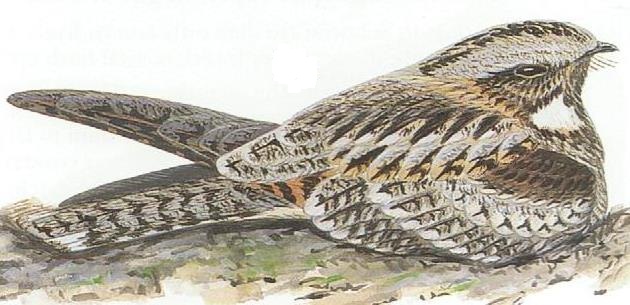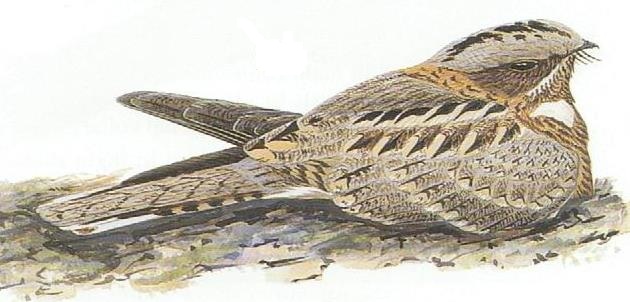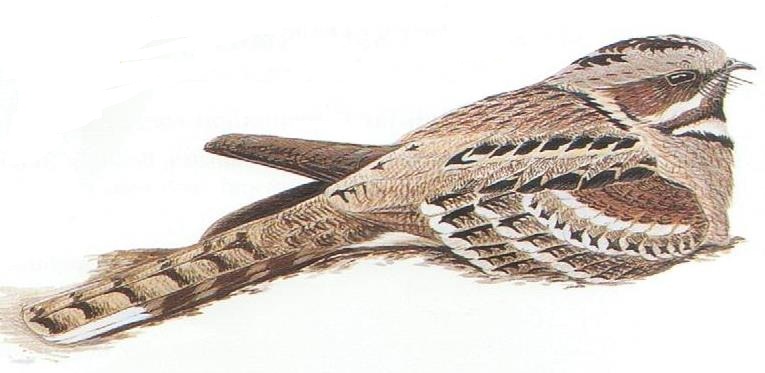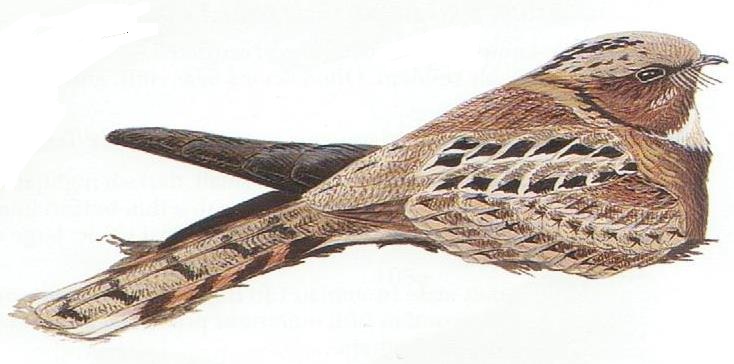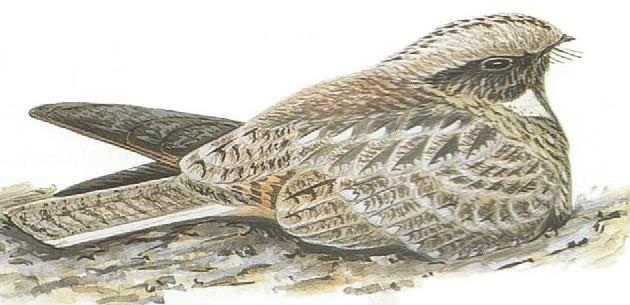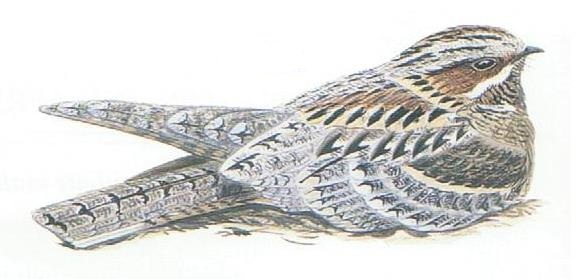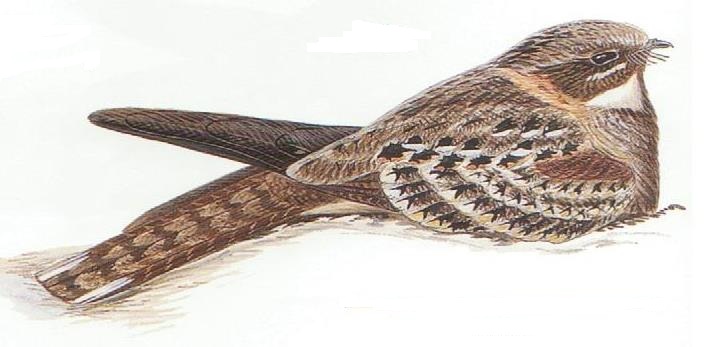Caprimulgus indicus Latham, 1790(Jungle Nightjar)
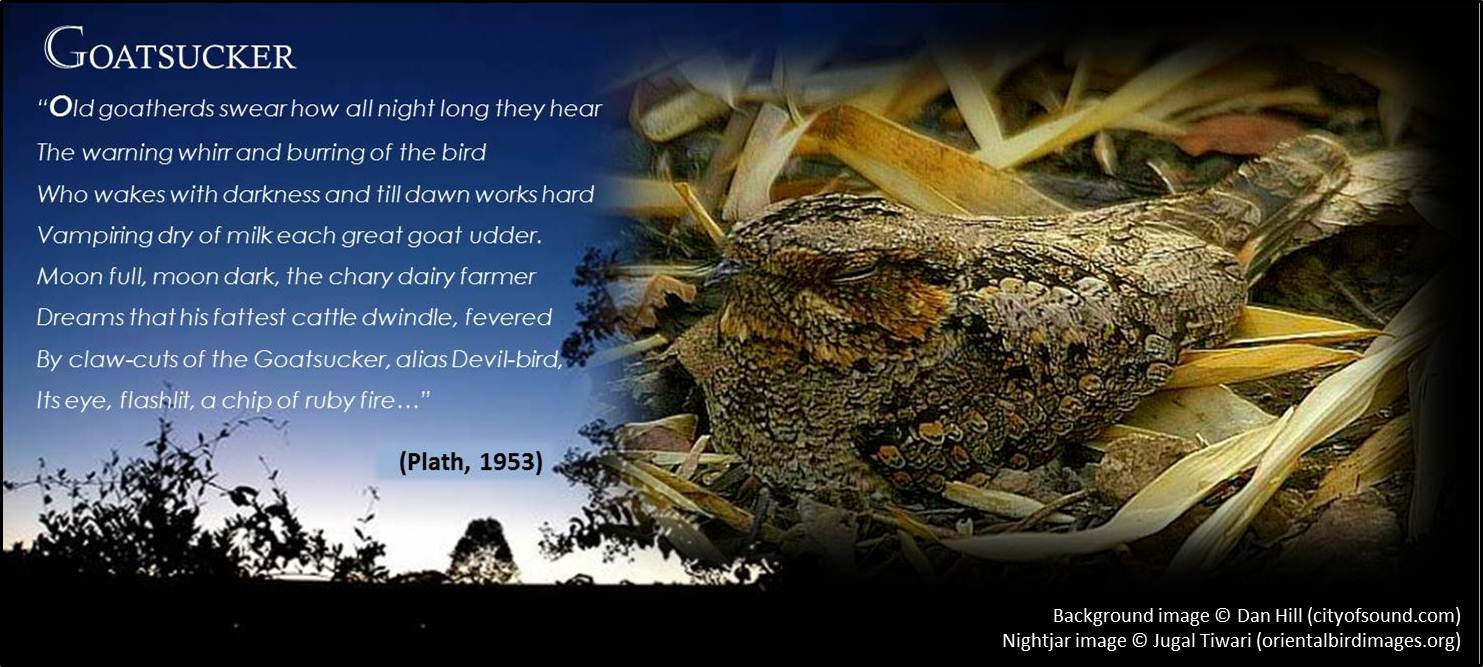
Table of Contents
ETYMOLOGY
The genus epithet, Caprimulgus is derived from the Latin words with capra being Latin for a nanny goat and mulgere meaning to milk (Cleere, 1999). As indicated by the poem by Sylvia Plath (above), local folklore tell the tales of shadowy birds that were to gather around the goats of shepherds old during dusk. With milk seen dripping from the teats of these breeding females in the morn next day, it was believed to be the doing of the birds during the night. Dating back (at least) to the time of Aristotle or even earlier, this tale was widespread throughout Europe, earning the bird names like the goatsucker (English), Ziegenmelker (German), kodozoi (Russian) and chotachabras (Spanish) - all coming to mean 'a milker of goats'.
TAXONAVIGATION
From Integrated Taxonomic Information System (ITIS) Report
Kingdom: Animalia
Phylum: Chordata
Class: Aves
Order: Strigiformes
Family: Caprimulgidae
Genus: Caprimulgus Linnaeus, 1758[1]
Species: Caprimulgus indicus Latham, 1790
- Subspecies: Caprimulgus indicus indicus Latham, 1790
- Subspecies: Caprimulgus indicus hazarae Whistler & Kinnear, 1935
- Subspecies: Caprimulgus indicus jotaka Temminck & Schlegel, 1845[2]
- Subspecies: Caprimulgus indicus kelaarti Blyth, 1851
- Subspecies: Caprimulgus indicus phalaena Hartlaub & Finsch, 1872
DISTRIBUTION
 |
| Fig. 1 Distribution and Movements (Cleere, 1999) (© Yale University Press) |
- _From Cleere, 1999
- _ 1) C. i. indicus: India S of Himalayas (absent W. Rajasthan and Kachchh)
- _ 2) C. i. hazarae: NE Pakistan E across Himalaya to NE India, Bangladesh and S China (Yunnan), S through Myanmar and Malay __.._Peninsula
- _ 3) C. i. kelaarti: Sri Lanka
- _ 4) C. i. jotaka: SE Siberia, E, C & S China, Japan and Korea; winters from S China to Greater Sundas and Philippines
- _ 5) C. i. phalaena: Palau Island
DESCRIPTION
From Latham, 1787
"Crown and back whitish ash-colour, elegantly marked with minute dusky lines:cheeks, breast, wing coverts, and secondaries, beautifully marked in the same manner with lines and large spots of rust: prime quills dusky: middle feathers of the tail light ash, crossed with a few black bars; outmost feather rusty and black."
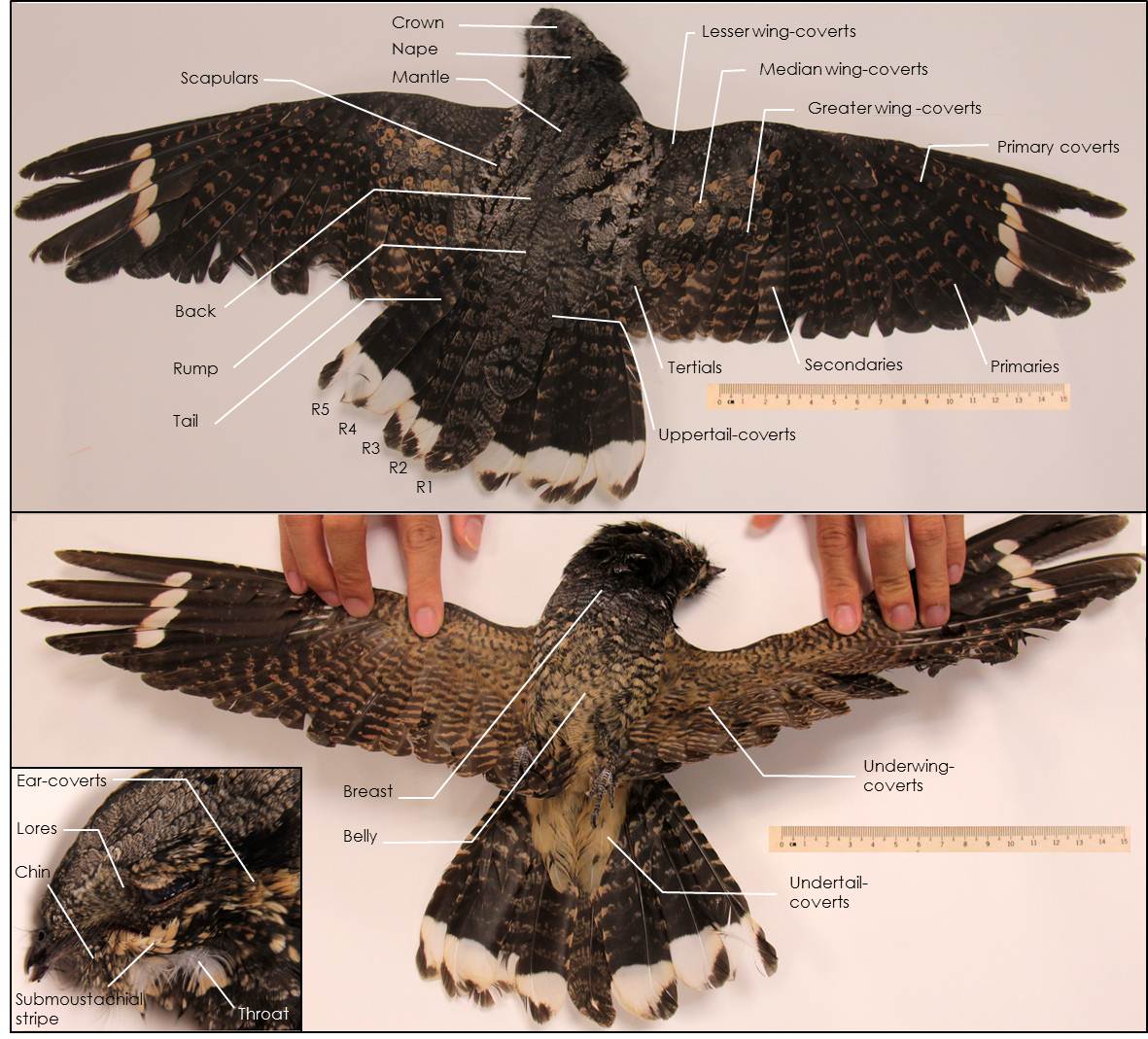 |
| Fig. 2 Montage display shows the dorsal (top), ventral (bottom) and the head (inset) of a male Jungle Nightjar. The specimen was dead when found and collected by Mr. Benjamin Ho at the National Institute of Education (NIE) of the Nanyang Technological University, Singapore on 12 April 2011. (Pictures © Ang Yuchen, 2011) |
From Cleere, 1998
Adult male (C. i. indicus)
- ♦ Forehead, crown and nape: greyish-brown streaked blackish-brown, broadly so on crown
- ♦ Hindneck: indistinct pale buff or tawny-buff collar
- ♦ Mantle, back, rump and uppertail coverts: greyish-brown, speckled and faintly barred pale brown, streaked blackish-brown.
- ♦ Lesser coverts: brown, speckled pale buff, tawny or greyish-white
- ♦ Wing coverts (remaining):
- a) Innerwebs: greyish-brown mottled pale buff or greyish-white
- b) Outerwebs: brown, boldly spotted pale buff, pale tawny or greyish-white on tips; spots smudged/vermiculated brown.
- ♦ Scapulars: blackish-brown, broadly edged greyish-white vermiculated brown
- ♦ Primaries:
- a) brown, large white spot, almost midway along feather, on innerweb of P10 and across both webs of P9-P7, P10 often spotted buff along edge of outerweb
- b) P9-P7 regularly spotted tawny above white spot
- c) inner six primaries regularly barred tawny
- ♦ Secondaries: brown-tipped with greyish mottling, regularly barred tawny, barring becoming paler on inner secondaries
- ♦ Tertials: brown densely mottled greyish-brown
- ♦ Tail:
- a) brown, indistinctly barred pale tawny or greyish-brown
- b) R5-R2 tipped white (17-30mm), distally speckled or washed brown, often broadly so
- c) central pair (R1) greyish-brown, mottled and barred brown
- ♦ Lores and ear coverts: brown, speckled pale buff/pale tawny-buff
- ♦ Submoustachial stripe: buffish white
- ♦ Chin and throat: brown barred buff
- ♦ Throat (lower): large white patch on either side - lower feather are tipped dark brown, with a buff or pale tawny subterminal band
- ♦ Breast: greyish-brown, finely barred brown and pale buff
- ♦ Belly flanks, undertail- and underwing-coverts : buff barred brown
From Cleere, 1998
Adult female
- Similar to the male except:
- ♦ Primaries: P10-P7 with small tawny or pale tawny spot, often heavily washed brown on innerweb
- ♦ Tail: R5-R2 narrowly tipped brownish-white or brownish-buff
From Cleere, 1998
Geographical Variation
- C. i. indicus: Described above. A generally brownish race and not too variable in colour, although greyish birds with whiter markings do occur.
- C. i. hazarae: Larger and darker brown than the nominate (i.e. C. i. indicus). The markings on the back are heavier, the barring on the tail broader and the throat-patches are tawnier.
- C. i. jotaka: Larger, darker and darker-breasted than the nominate.
- C. i. kelaarti: Smaller than the nominate and darker grey with whiter markings. The barring on the tail is heavier.
- C. i. phalaena: Smaller than the nominate, and perhaps more rufous brown.
DIAGNOSIS
Showcasing the topography of the nightjar and its respective terminology, the figure below (Fig. 3.1) serves as a point of reference for readers to compare and contrast its body parts and plumage to the Jungle Nightjar (Fig. 3.2) and other similar species in subsequent figures (Fig. 3.3 - 3.8). All images below are from Cleere, 1998, copyright of Yale University Press, New Haven and London. (approval pending)
 |
| Fig. 3.1 General topography and morphology of nightjars (Caprimulgidae). The inset image illustrates an example of a nightjar's primary feather. (From Cleere, 1998) |
| ADULT. (male nominate) |
IN FLIGHT † (male = top left; female = bottom right) |
DESCRIPTION. (includes dimorphic differences between gender) |
||
|
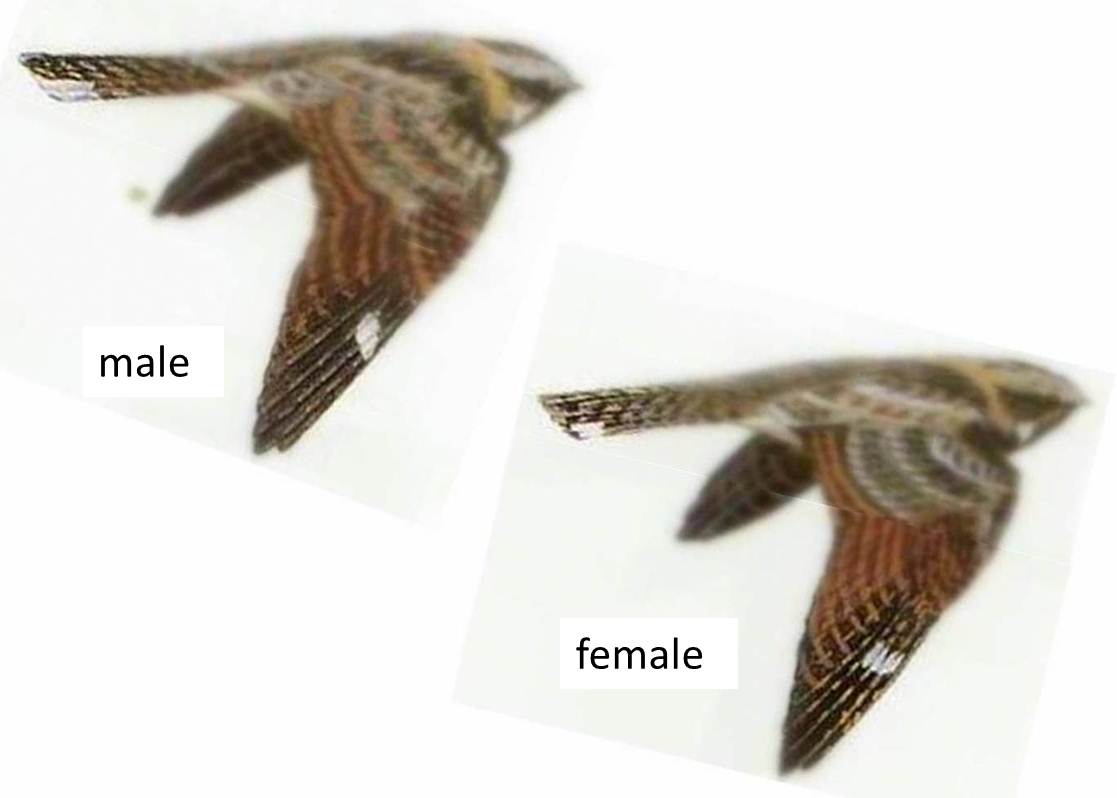 |
"The identification of the species can be accurately determined by the greyish ground colour, the lack of a hindneck collar, the bold, buff spots on otherwise uniform wing-coverts and the broad white tips to the four outer tail feathers" (Cleere, 2002).
|
- ... and in comparison to other similar species such as...
| ADULT. (male nominate) |
IN FLIGHT † (male = top left; female = bottom right) |
DESCRIPTION. (includes dimorphic differences between gender) |
||||
|
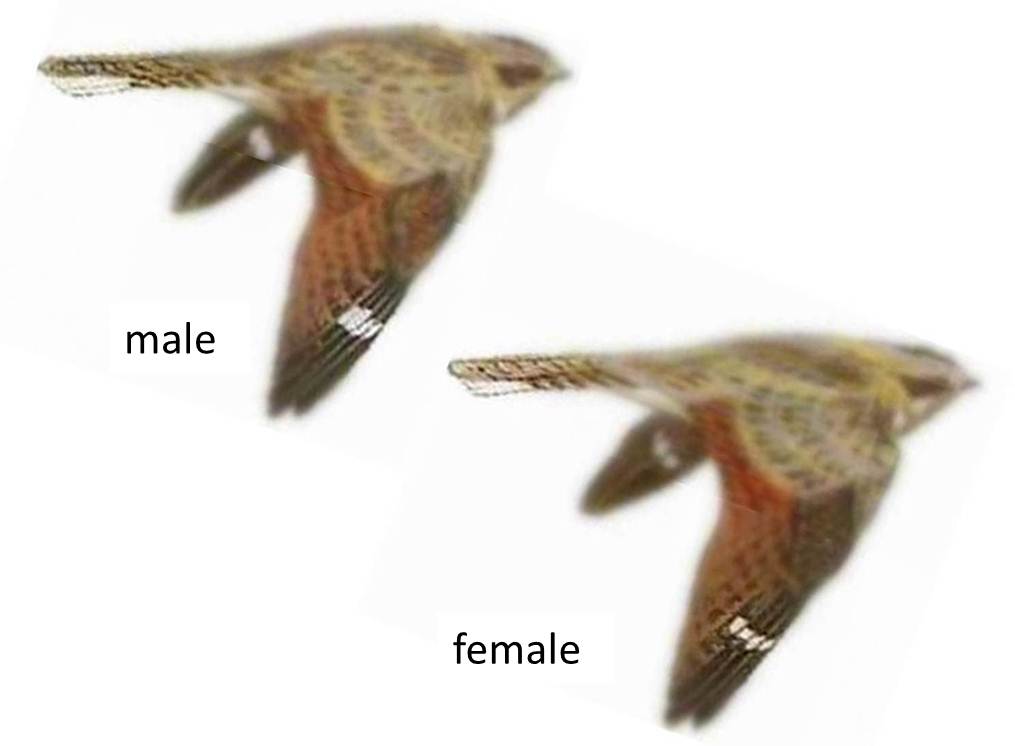 |
|
||||
|
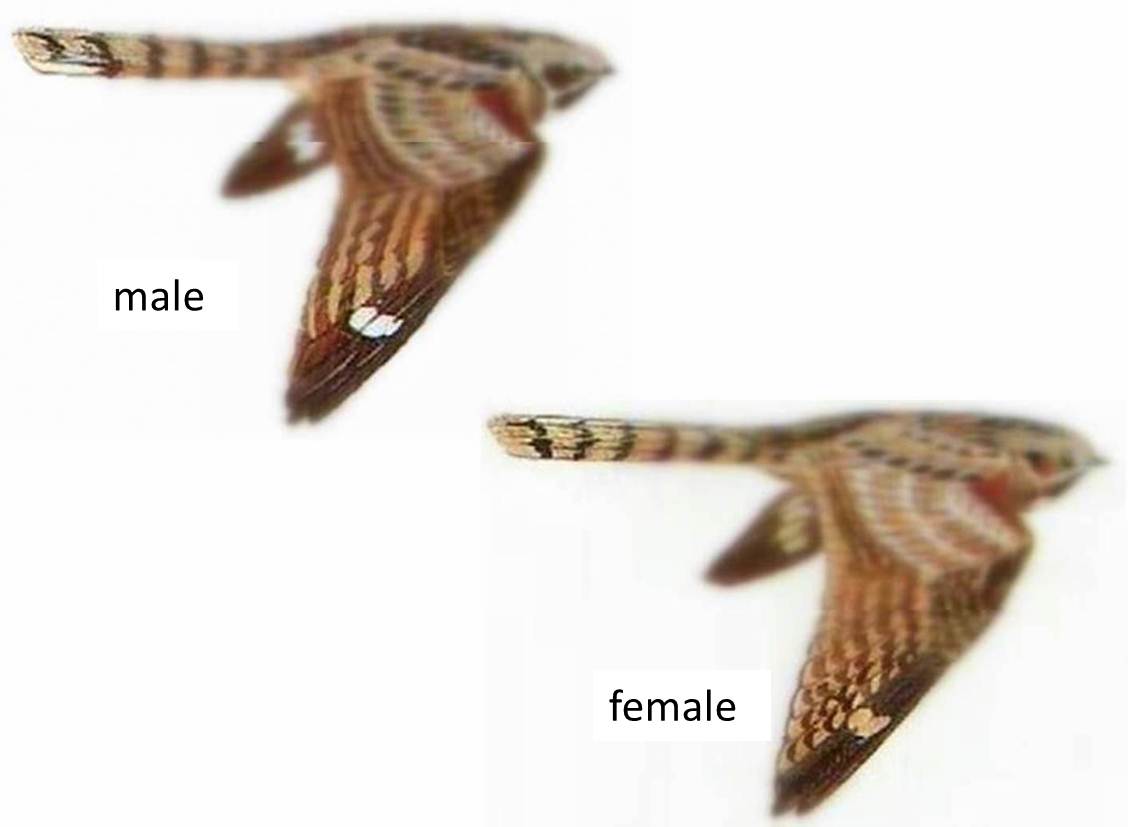 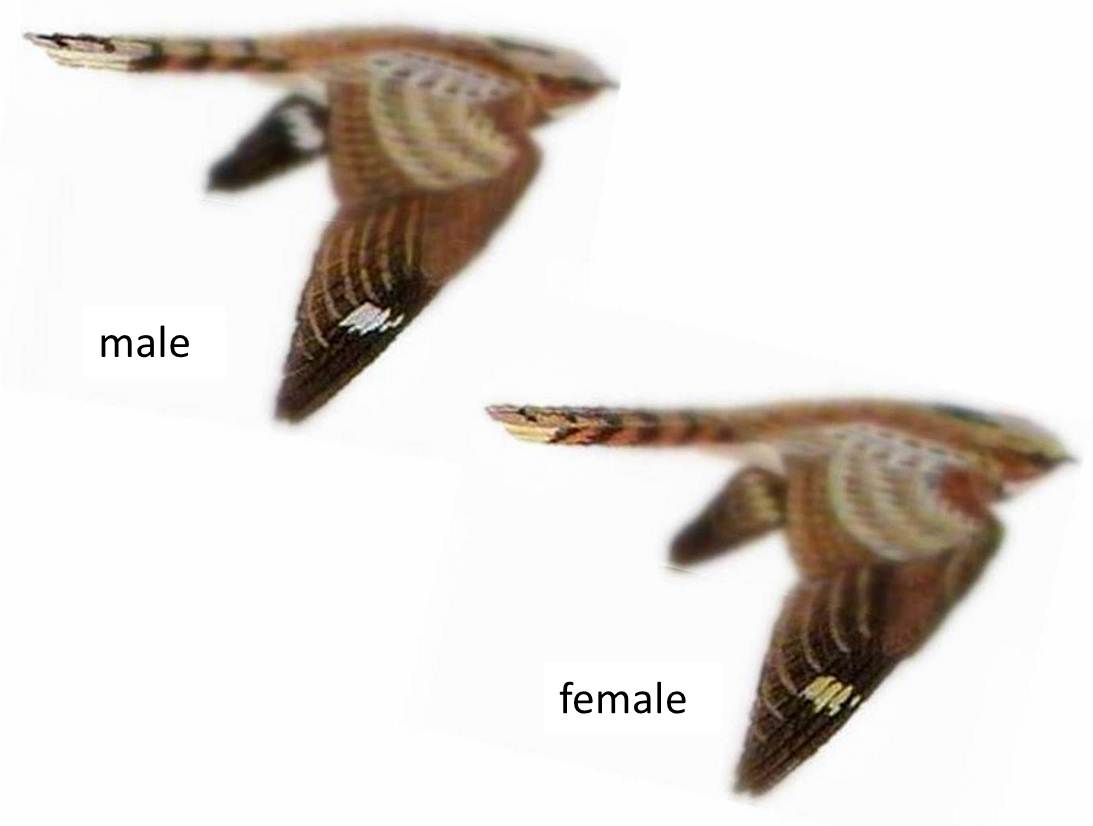 |
|
||||
|
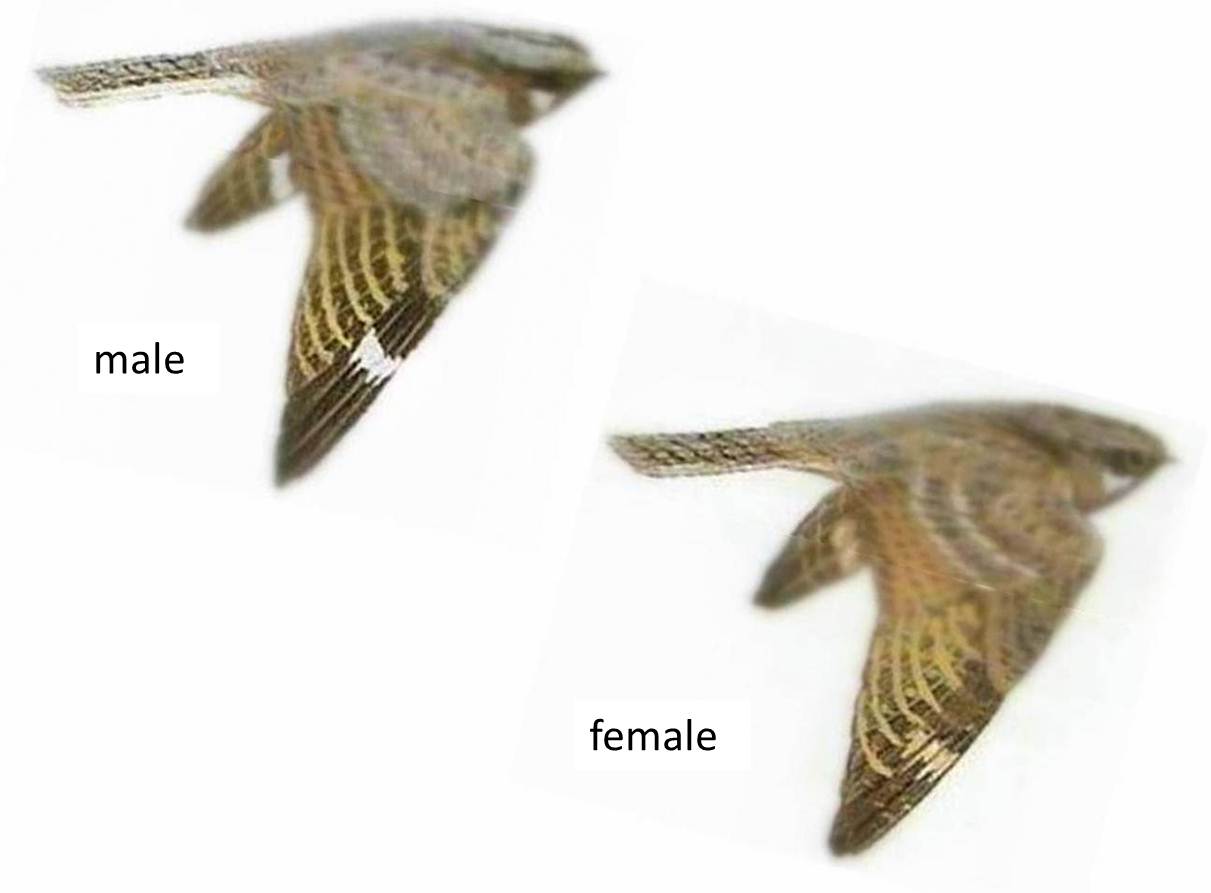 |
|
||||
|
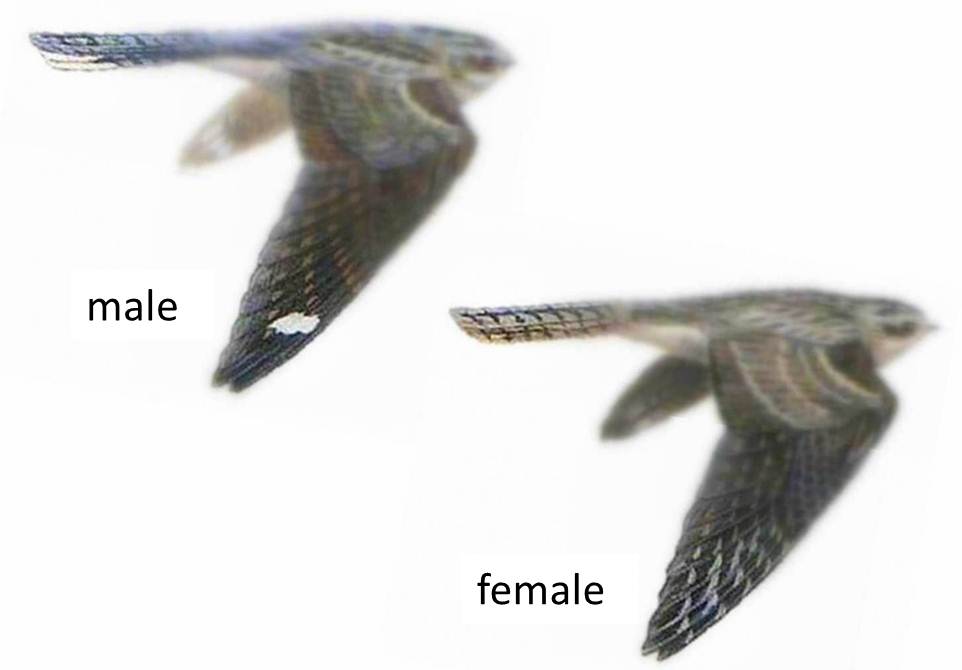 |
|
||||
|
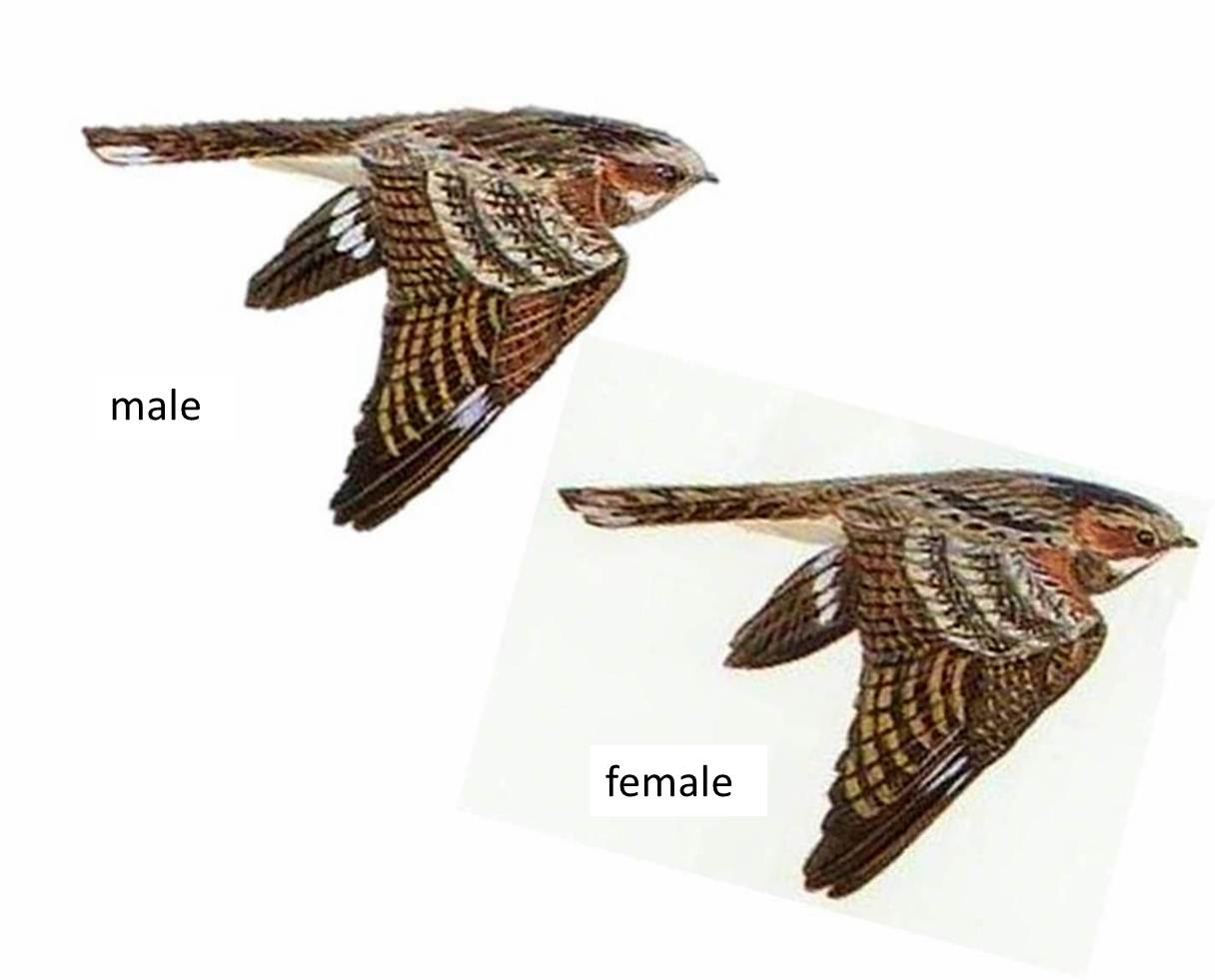 |
|
VOICE
From Cleere, 1999 (unless stated otherwise)
- Song (of male): consist of "a rapid series of loud “tuk, tuk, tuk, tuk” notes, also a repetitive “tukoo, tukoo, tukoo” that occasionally ends with a hollow “wowowowow”."
- ♦ sings from perches, from ground and in flight
- ♦ may be heard mainly at dusk and dawn and throughout the night, especially when there is plenty of moonlight
- ♦ migratory races occasionally sing briefly on the wintering grounds
- Calls: consist of "rapid sets of deep “quor” or soft “you” sounds."; male's flight call in Sri Lanka noted as “hóó, hóó, hóó, hóóteter”.
Listen to call: HERE
- ★ In Singapore, there are three other resident nightjars native to the country (The Birds of Singapore, 2010). Listed below are these nightjars and the sites that contain their respective calls:
The Internet Bird Collection
- In addition to images, this website also provides additional tracks and videos on the Jungle Nightjar and its calls/songs.
BIOLOGY
From Cleere, 1999 (unless stated otherwise)
Habitat
- Recorded from sea level to 3300 m.
- ♦ mainly forest, woods and wooded country, in open woodland, deciduous , pine and mixed bamboo forest, glades and thick brush jungle
- ♦ open scrubland, farmland and cultivation, mandarin orange (Citrus reticulata) orchards and teak plantations.
- ♦ sparsely vegetated ravines and on jungle-clad hillsides (e.g. in Himalayas)
- ♦ stony fields (e.g. in Sri Lanka)
- ♦ large cities (e.g. Kuala Lumpur, Malaysia), especially by wintering and passage birds
- ★ In Singapore, it was mostly heard and/or observed in areas with higher vegetation density such as:
- a) Central Catchment Nature Reserve (e.g. Lower Peirce Reservoir, MacRitchie and Sime Forest areas)
- b) Bidadari Cemetery (e.g. 2009; 2010)
- c) Chinese Gardens
- d) Singapore Botanic Gardens
- e) Sentosa
From Salim & Dillon, 1983 (unless stated otherwise)
General habits
- Crepuscular and nocturnal.
- ♦ After dusk, it prefers squatting in the middle of cross-country earth tracks - its eyes glow red in the headlights of an oncoming car, and is skilled at evading by flip-flap zigzags when close to being run over.
- ♦ During daytime, it will roost in a shady spot as roost squatted lengthwise on a bough, OR on the ground among dry leaves and stones where its coloration matches with the background.
- ★ In Singapore, it has been noted to roost on a tree branch about 7 metres from the ground (Tsang, 2009) - higher roosts are preferred to lower ones such as rocks, tree stumps etc. Indeed, local birders, Koh et al. (2008) noted that this roosting preference was different from the resident Large-tailed Nightjars (Caprimulgus macrurus), which are usually seen on the ground.
- Flight and non-flight motions:
- ♦ Flight is utterly silent akin to the soft-plumaged owls, except for an occasional hit of the wing-tips during the rapid twists and turns.
- ♦ Running the occasional short distances is possible in spite of their very short legs; for instance, at the nest site, "with a shuffling, waddling gait, often with the wings raised almost vertically back-to-back".
From Cleere, 1999 (unless stated otherwise)
Feeding habits
- Diet includes "moths, beetles (including Scarabaeidae ), bugs, flying ants, cicadas, grasshoppers, locusts and small wasps"; also, feeds on insects attracted to artificial lights.
- ★ In Singapore, they have also been observed to take advantage of a termite hatch event - the nightjars were seen "catching the termites at least a half hour before their usual dusk activity period" (Subaraj, 2006).
- Hunting is either done close to ground, OR high up over trees - "its foraging flight is extremely agile and buoyant".
From Cleere, 1999 (unless stated otherwise)
Reproduction
- Courtship behaviour:
- The male glides with his wings held in a V above his back during courtship flight; his tail will be fanned and angled while calling simultaneously (See Voice). It has been observed to frequently wing-clap.
- Breeding months:
- ♦ Japan: late May – early Aug
- ♦ Himalayas: Mar – Jun (mainly Apr – May)
- ♦ Pakistan: late April – Jul
- ♦ India: Feb – May (mainly Mar – Apr); late Feb – Aug in S India.
- ♦ Sri Lanka: Feb – Jul
- Nest site:
- ♦ If nest is build: it is observed to be "near or on rock, beneath vegetation, in thicket, on stony slope or in ravine".
- ♦ If no nest is build: eggs are observed to be "laid on leaf litter, bare ground, or ashes following bush fires".
- Egg attributes:
- ♦ Clutch size: 1-2 eggs
- ♦ Shape: elliptical
- ♦ Colour: creamy-white, spotted and marbled grey, brown and umber . Eggs have been described by several researchers as (Holyoak, 2001)
- a) C. i. indicus (and C. i. kelaarti):
- (i) "pale red-brown ground-colour" OR
- (ii) "being pinkish-white with rather sparse brown spots" OR
- (iii) "warm cream to pinkish-buff, spotted irregularly with scattered blackish-brown spots" OR
- (iv) "pale creamy to warm buff, spattered irregularly all over with blackish- or reddish-brown spots"
- b) C. i. hazarae (and C. i. jotaka):
- (i) "White, pale cream" OR
- (ii) "pale greyish-white marbled with dark grey or grey-brown and with overlying spots of clear grey"
- Incubation:
- ♦ Period: usually 16 – 19 days - generally by female, male taking turns at dusk and dawn; chicks covered in brown and buff down, fledges at c. 17 days
- ♦ Behaviour:
- (i) When undisturbed, incubating birds will "adopt a rather upright posture with its foreparts erect, suggesting a lichen-covered stone or a piece of wood".
- (ii) When threatened, incubating birds sit very tightly and rely on cryptic coloration as the main defense mechanism. It will continue to watch the potential threat through half-closed eyelids - ever-ready to spring up and fly to a perch in a nearby tree (e.g. in danger of being trodden upon).
STATUS & CONSERVATION
From Cleere, 1999 (unless stated otherwise)
- "Adaptable, often occupying areas of deforestation and cultivation"
- Pakistan: locally common summer visitor in NE part
- India: common - resident in many regions, locally migratory in others
- Sri Lanka: locally common (perhaps more in E)
- China: fairly widespread throughout[3]
- Japanese islands: local but not uncommon summer visitor
(e.g. Kyushu, Shikoku, Honshu and Hokkaido) - Russia: locally common to abundant in the E and SE parts
- Malaysia: fairly common passage migrant and winter visitor throughout
- Philippines: rare winter visitor
- Borneo: widespread winter visitor, possibly more regular at higher altitudes
- ★ Singapore: Uncommon passage migrant and winter visitor (Subaraj et al., 2006)
From BirdLife International, 2009
- Listed as 'Least Concern' on the IUCN Red List in 2009.
- Justification: Range size[a], population trend[b] and population size[c] of the species do not approach the thresholds of the ‘Vulnerable’ category[4].
TYPE INFORMATION
From Global Biodiversity Information Facility (GBIF), 2007
Dataset
- Data Publisher: University of Michigan Museum of Zoology
- Dataset: Bird specimens
- Institution code: UMMZ
- Collection code: Bird
- Catalogue No: 142097
- Basis of record: PreservedSpecimen (interpreted as Specimen)
- Collector name: Koelz, Walter N
- Date collected: 2 / 4 / 1953 (interpreted as Apr 2, 1953)
Taxonomy
- Scientific name: Caprimulgus indicus hazarae
- Specimen type status: Holotype
- Sex: Male
Geospatial
- Continent: Asia
- Country: India
- State/Province: Mizoram
- County: Lushai Hills
- Locality: Blue Mountain
- Latitude: 23.390356
- Longitude: 92.718309
FOOTNOTES
- ^ A recent study carried out by Barrowclough et al. (2006) suggests a possible redefinition of the genus Caprimulgus with many consequent nomenclatural divisions (Christidis & Boles, 2008). But, since C. indicus was exempted from the study, its generic epithet and position are uncertain; it will be retained in Caprmulgus until more species are studied.
- ^ C. i. jotaka has been elevated to species by Rasmussen and Anderton (2005) to C. jotaka. Differences between C. indicus and C. jotaka are demonstrated through their songs (e.g. the former gives a disyllabic series compared to the monosyllabic series of the latter) and the hues of their eggs - the difference is unusual if both specimens were derived from the species since the egg type of the Caprimulgidae birds tend to be conservative (Rasmussen, 2005; Martens & Bahr, 2007). However, this is still inconclusive as many websites (e.g. ITIS, GBIF, IUCN Red List) still regard it as a subspecies of C. indicus.
- ^ C. indicus is one of the species protected in the Sichuan province.
- ^ Criterion for species listed as ‘Vulnerable’:
- (a) Extent of occurrence is <20,000 km2 combined with a declining or fluctuating range size, habitat extent/quality, or population size and a small number of locations or severe fragmentation
- (b) >30% decline over ten years or three generations.
- (c) <10,000 mature individuals with a continuing decline estimated to be >10% in ten years or three generations, or with a specified population structure.
LITERATURE & REFERENCES
Barrowclough, G. F., J. G. Groth and L. A. Mertz. 2006. The RAG-1 exon in the avian order Caprimulgiformes: Phylogeny, heterozygosity, and base composition. Molecular Phylogenetics and Evolution, 41: 238–248.
BirdLife International, 2009. Caprimulgus indicus. In: IUCN 2011. IUCN Red List of Threatened Species. Version 2011.1. www.iucnredlist.org. (Accessed 04 October 2011.)
Christidis, L. & Boles W.E., 2008. Systematics and taxonomy of Australian birds. CSIRO Publishing. 277pp.
Cleere, N., 1998. Nightjars: a guide to the nightjars, nighthawks, and their relatives. Yale Univ. Press, New Haven, CT. 320pp.
Cleere, N., 1999. Family Caprimulgidae (Nightjars) in del Hoyo, J., Elliott, A., & Sargatal, J., eds. Handbook of the Birds of the World. Vol. 5. Lynx Edicions, Barcelona. Pp 302 - 386.
Cleere, N., 2002. The original citation of Jerdon’s Nightjar Caprimulgus atripennis (Caprimulgidae). Forktail, 18: 147.
Global Biodiversity Information Faculty, 2007. Occurrence Details: UMMZ Bird 142097 Caprimulgus indicus hazarae. http://data.gbif.org/occurrences/45063297. Field Museum of Natural History, Museum of Vertebrate Zoology, University of Washington Burke Museum, and University of Turku. (Last indexed 6 Oct 2011.) (Accessed 16 Nov 2011.)
Holyoak, D. T., 2001. Nightjars and their Allies. Oxford University Press, New York. 824pp.
Integrated Taxonomic Information System Report, undated. Caprimulgus indicus Latham, 1790. Integrated Taxonomic Information System, USA. http://www.itis.gov/servlet/SingleRpt/SingleRpt?search_topic=TSN&search_value=177964. (Accessed 16 Nov 2011.)
Internet Bird Collection, undated. Jungle Nightjar (Caprimulgus indicus). http://ibc.lynxeds.com/species/jungle-nightjar-caprimulgus-indicus. (Accessed 16 Nov 2011.)
Koh, D., Meng & M. Chan, 2008. Grey Nightjar. http://www.besgroup.org/2008/01/15/grey-nightjar/. (Accessed 16 Nov 2011.)
Latham, J., 1787. Supplement to the General synopsis of Birds.Leigh and Sotheby, London. 358pp. http://www.archive.org/stream/supplementtogene00lath#page/196/mode/2up. (Accessed 16 Nov 2011.)
Martens, J. & N. Bahr, 2007. Dokumentation neuer Vogel-Taxa – Bericht für 2005. – Vogelwarte 45: 119–134.
National Center for Biotechnology (NCBI), undated. Caprimulgus indicus. http://www.ncbi.nlm.nih.gov/Taxonomy/Browser/wwwtax.cgi?id=433629. (Accessed 16 Nov 2011.)
Plath, S., 1981. The Collected Poems. Harper Perennial, USA. 351pp.
Rasmussen, P., 2005. Biogeographic and conservation implications of revised species limits and distributions of South Asian birds. Zoologische Medelingen Leiden 79(3): 137–146.
Rasmussen, P. C. & J. C. Anderton, 2005. Birds of South Asia: The Ripley Guide. Smithsonian Institution & Lynx Edicions.
Salim, A., & S. D. Ripley, 1983. Handbook of the Birds of India and Pakistan, Vol. 4. 2nd Edition. Oxford University Press.vol. 2, 268pp.
Subaraj, R., 2006. Termite Hatch. http://www.besgroup.org/2006/01/12/termite-hatch/. (Accessed 16 Nov 2011.)
Subaraj, R., Wee, Y. C., Chan, Y. M., Tsang, KC. & Tang, H. B., 2006. Territorial Nightjars. http://www.besgroup.org/2006/12/28/territorial-nightjars/. (Accessed 16 Nov 2011).
The Birds of Singapore, undated. A Checklist of all birds recorded in Singapore: Non-Passeriformes. (Last updated 3 Oct 2010.) (Accessed 16 Nov 2011).
Tsang, KC., 2009. Roosting of the Grey Nightjar. http://besgroup.talfrynature.com/2009/01/01/roosting-of-the-grey-nightjar/. (Accessed 16 Nov 2011.)
Xeno-canto, undated. All Species In The Collection. Xeno-canto Foundation. http://xeno-canto.org/all_species.php. (Accessed 16 Nov 2011.)
GENBANK RECORDS
COMMENTS & DISCUSSION
If you have any quick comments and/or queries pertaining to this page, please leave them in the comment box below. Alternatively, you may also leave them in the discussion page above.
| Subject | Author | Replies | Views | Last Message |
|---|---|---|---|---|
| No Comments | ||||
